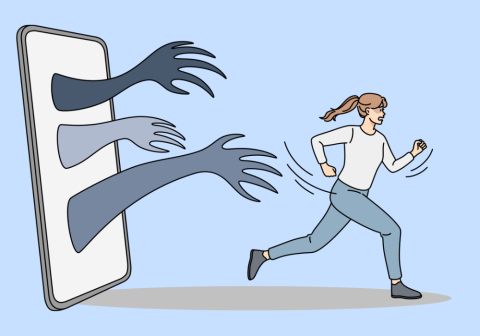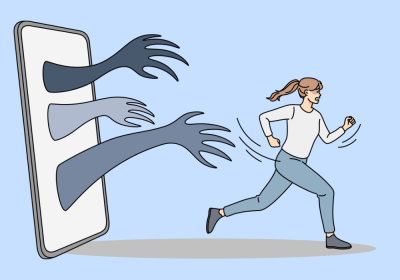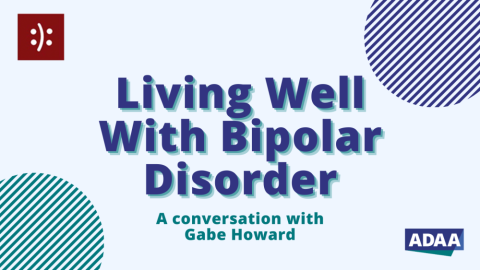
The Internet abounds in information and misinformation about panic attacks, phobias, and other anxiety disorders — including promises of quick cures that require up-front payment. When chronic anxiety disrupts your life, you may be willing to try anything. But how can you learn what’s trustworthy? And how can you find help that will work for you? Read on.
Finding Information Online
The Internet offers lots of information about anxiety, so how can you tell if it’s reliable or credible? Look for evidence-based practices, which are treatments that clinical research has shown to be effective. ADAA's website only provides evidence-based content reviewed/authored by our professional mental health members.
Here are the top five ways:
- Review ADAA Resources:
- Visit the websites of these recommended organizations, learn about treatment options, and contact ADAA for more information.
- Sign up to receive Triumph, the ADAA monthly e-newsletter and other occasional e-mails.
- Look for credentials:
- Look for academic degrees, professional and state licenses, association memberships, and other evidence of experience for the authors of any website. A “leading expert” or fellow panic sufferer might not offer the treatment that’s best for you.
- Also, visit the National Institute of Mental Health (NIMH) website to find the types of treatment that are recommended. Many university health centers also offer treatment.
- Beware of extravagant claims — instant cures, guaranteed results of never again having anxiety symptoms, revolutionary formulas, “natural” or unique methods or techniques that require payment — and products “exclusively available from this website.” Just because it says “scientifically proven” doesn’t mean it’s true.
- When you participate in a forum, message board, or chat room, be aware that while it’s easy to get information from other people that appears helpful, it may work against your recovery. Peers may offer valuable insight, but be sure to check any advice with a mental health professional.
- Learn more about Internet anxiety scams by psychologist David Carbonell, PhD, an expert on anxiety disorders and a member of ADAA. Become an informed consumer to find the most effective treatment for you.
Common Anxiety Myths
There are many misconceptions and myths about Generalized Anxiety Disorder (GAD). We've compiled a list of 10 common myths and provided the reality for each of them. You can download this infographic with a comparison of the myths and realities of GAD, or you can read them below.
ADAA Resources
- What is Anxiety? Video
- Generalized Anxiety Disorder (GAD) Brochure
- ADAA Board Statement on Trauma - 2023
Webinars:
- Book Conversations - 3 Part Series on Overcoming Anxiety
- Calming the Inner-Chatter of Your Mind
- Thriving with Anxiety and Depression
- What Are Intrusive Thoughts and How Can You Deal with Them?
- Outsmart Your Anxious Brain
- The Mindful Way Through Anxiety
- Get Unstuck from Depression and Anxiety with Acceptance and Commitment Therapy
- Building the Confidence to Manage Anxiety, ADHD, and Executive Function
Blogs:
Myth + −
- Snap a rubber band on your wrist every time you have a bad thought
- If a panic attack gets too bad, you can pass out or lose control
- If you have an anxiety disorder, it is important to avoid stress and situations that make you feel "stressed"
- Always carry a paper bag in case you hyperventilate
- The causes of anxiety disorders are usually rooted in childhood, so effective therapy must focus on that time period
- Medications for anxiety are addictive so they should be taken only if absolutely necessary
- Medication is the only treatment for anxiety disorders
- Some people are just worrywarts or neurotic, and there is nothing that can really make any difference
- If you eat right, exercise, avoid caffeine, and live a healthy lifestyle, your anxiety will go away
- A never-ending supply of compassionate reassurance from family and friends and assistance in avoiding stress is good for someone with anxiety problems
Reality + −
- Studies show that suppressing your thoughts makes them stronger and more frequent. Think of it this way: The thoughts you resist persist.
- It's unlikely you will faint, which is caused by a sudden drop in blood pressure. During a panic attack, your blood pressure does not fall; it actually rises slightly.
- Treating yourself as if you are fragile and avoiding risk leads to feeling demoralized. Avoiding anxiety tends to reinforce it. You can be anxious and still do whatever you have to do.
- Paper bags can serve as safety crutches that keep you anxious about being anxious. Hyperventilation, while uncomfortable, is not dangerous.
- Research shows that effective treatment focuses on the here and now, including new skills to manage thoughts, emotions, discomforts, and behavior.
- SSRI and SNRI antidepressants are not addictive. Benzodiazepines might be helpful in the short term, but they can lead to increased tolerance and dependence after long-term use.
- Medication can be effective. But scientific research shows that cognitive-behavioral therapy (CBT) may be just as or more effective than medication (or a combination of CBT and medication) for most people, especially in the long run.
- Therapy can help you reduce worry and suffering and learn a different relationship to your own thoughts, regardless of your temperament and how long neurotic habits have been in your life.
- while some of your anxiety might go away, your disorder won't be cured. Anxiety disorders are certainly sensitive to stress, but stress does not cause them. You need more help than just reducing your stress. You may need to face your fears, learn new facts about your symptoms, stop avoiding, learn tolerance for some experiences, or change how you think, feel, and behave with respect to other people.
- Well-meaning friends/family can inadvertently get caught up in reassurance compulsions and also help maintain fears by keeping you from facing them. Compassionate and kindly encouragement to move through anxiety and doubts, instead of avoiding them, is more helpful.
















